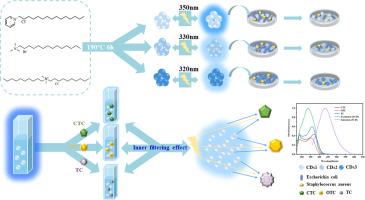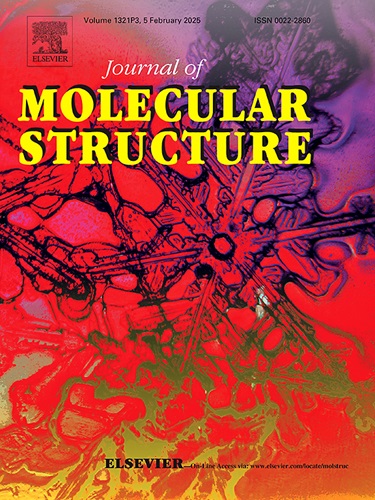Quaternary ammonium salt-derived carbon dots for antibacterial efficacy and tetracycline sensing
IF 4.7
2区 化学
Q2 CHEMISTRY, PHYSICAL
引用次数: 0
Abstract
Bacterial infections pose a significant threat to global health, necessitating the development of novel antibacterial materials. Tetracycline antibiotics (CTC, OTC, TC) are low-cost and widely abused in recent years. However, they were easily absorbed by the human body and long-term exposure to tetracycline could contribute to some adverse reactions and diseases. So there is a need for novel antimicrobial agents and a rapid, sensitive detection method of tetracycline antibiotics. In this study, we synthesized three carbon dots (CDs1, CDs2, CDs3) from quaternary ammonium salts via a hydrothermal method. Antibacterial assays against Staphylococcus aureus and Escherichia coli demonstrated their potent antibacterial activity with minimum inhibitory concentrations(MIC) determined as 39 μg/mL, 78 μg/mL, and 9.8 μg/mL, respectively. Notably, CDs3 exhibited the highest antibacterial effectiveness, attributed to its smaller size and higher chlorine content compared to CDs1 and CDs2. Additionally, CDs1, characterized by its high fluorescence quantum yield and stability, demonstrated remarkable specificity and robust anti-interference capabilities in detecting tetracycline antibiotics, including chlortetracycline (CTC), oxytetracycline (OTC), and tetracycline (TC). Leveraging the internal filtration effect mechanism, CDs1 exhibited detection limits of 0.18 μmol/L for CTC, 0.15 μmol/L for OTC, and 0.13 μmol/L for TC, respectively. The effectiveness of this detection method was further confirmed through validation in real milk samples, confirming the practical utility of CDs1 in food safety testing. The low toxicity of carbon dots were synthesized using a simple one-step hydrothermal method, which was fast, cost-effective, and easy to achieve large-scale production. Our findings underscore the potential of CDs derived from quaternary ammonium salts, demonstrating promising performance in antibacterial applications and providing insights into food safety testing methodologies.

用于抗菌功效和四环素传感的季铵盐衍生碳点
细菌感染对全球健康构成重大威胁,因此有必要开发新型抗菌材料。四环素类抗生素(CTC、OTC、TC)价格低廉,近年来被广泛滥用。然而,它们很容易被人体吸收,长期接触四环素会导致一些不良反应和疾病。因此,需要新型抗菌剂和快速、灵敏的四环素类抗生素检测方法。在这项研究中,我们通过水热法从季铵盐中合成了三种碳点(CDs1、CDs2、CDs3)。针对金黄色葡萄球菌和大肠杆菌的抗菌试验表明,它们具有很强的抗菌活性,最低抑菌浓度(MIC)分别为 39 μg/mL、78 μg/mL 和 9.8 μg/mL。值得注意的是,与 CDs1 和 CDs2 相比,CDs3 的尺寸更小,氯含量更高,因此抗菌效果最高。此外,CDs1 具有高荧光量子产率和稳定性的特点,在检测四环素类抗生素(包括金霉素(CTC)、土霉素(OTC)和四环素(TC))方面表现出显著的特异性和强大的抗干扰能力。利用内部过滤效应机制,CDs1 对 CTC 的检测限为 0.18 μmol/L,对 OTC 的检测限为 0.15 μmol/L,对 TC 的检测限为 0.13 μmol/L。通过在真实牛奶样品中的验证,进一步证实了这种检测方法的有效性,从而证实了 CDs1 在食品安全检测中的实用性。低毒性的碳点是用简单的一步水热法合成的,这种方法快速、经济、易于实现大规模生产。我们的研究结果凸显了从季铵盐中提取的碳点的潜力,证明了其在抗菌应用中的良好性能,并为食品安全检测方法提供了启示。
本文章由计算机程序翻译,如有差异,请以英文原文为准。
求助全文
约1分钟内获得全文
求助全文
来源期刊

Journal of Molecular Structure
化学-物理化学
CiteScore
7.10
自引率
15.80%
发文量
2384
审稿时长
45 days
期刊介绍:
The Journal of Molecular Structure is dedicated to the publication of full-length articles and review papers, providing important new structural information on all types of chemical species including:
• Stable and unstable molecules in all types of environments (vapour, molecular beam, liquid, solution, liquid crystal, solid state, matrix-isolated, surface-absorbed etc.)
• Chemical intermediates
• Molecules in excited states
• Biological molecules
• Polymers.
The methods used may include any combination of spectroscopic and non-spectroscopic techniques, for example:
• Infrared spectroscopy (mid, far, near)
• Raman spectroscopy and non-linear Raman methods (CARS, etc.)
• Electronic absorption spectroscopy
• Optical rotatory dispersion and circular dichroism
• Fluorescence and phosphorescence techniques
• Electron spectroscopies (PES, XPS), EXAFS, etc.
• Microwave spectroscopy
• Electron diffraction
• NMR and ESR spectroscopies
• Mössbauer spectroscopy
• X-ray crystallography
• Charge Density Analyses
• Computational Studies (supplementing experimental methods)
We encourage publications combining theoretical and experimental approaches. The structural insights gained by the studies should be correlated with the properties, activity and/ or reactivity of the molecule under investigation and the relevance of this molecule and its implications should be discussed.
文献相关原料
公司名称
产品信息
索莱宝
trypsin-EDTA solution
 求助内容:
求助内容: 应助结果提醒方式:
应助结果提醒方式:


